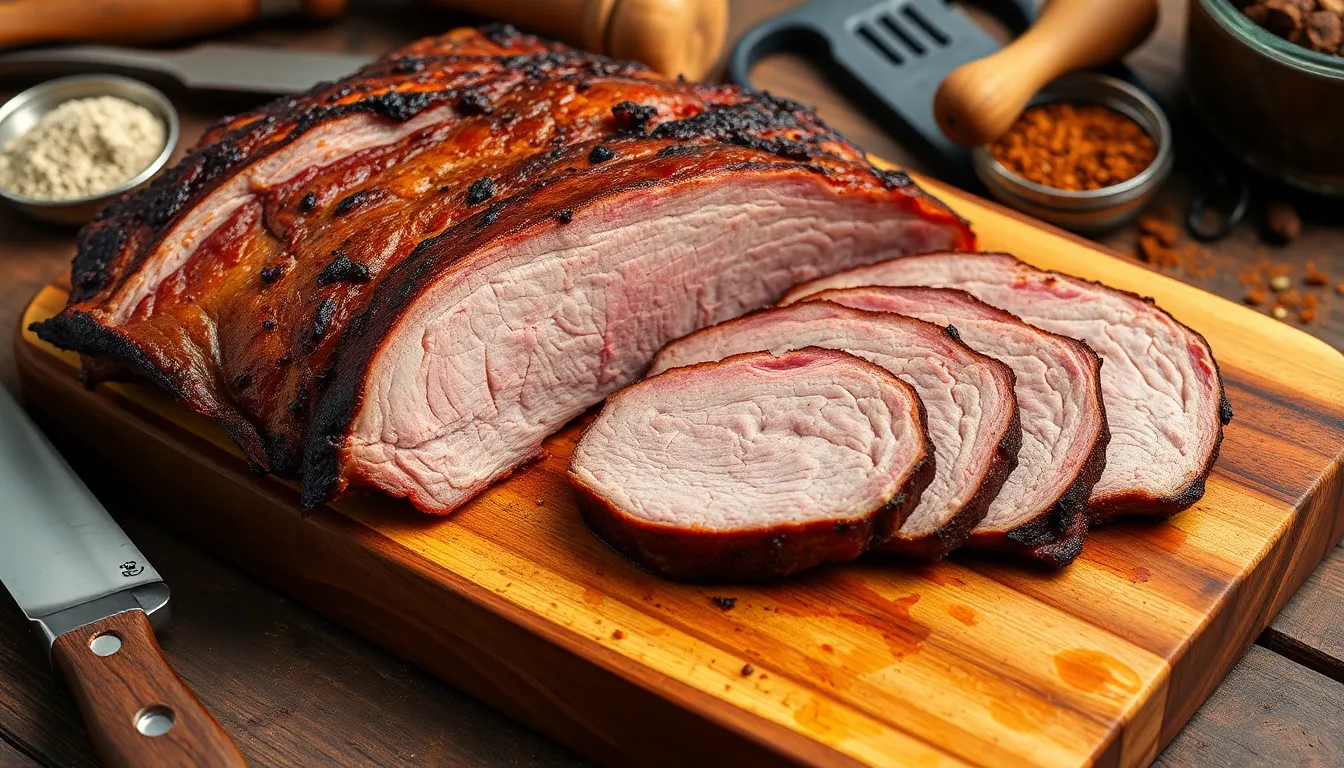Brisket lovers unite! When it comes to mastering the art of barbecue, understanding the brisket flat and point is as crucial as knowing the difference between a spatula and a tongs. This dynamic duo of deliciousness holds the key to mouthwatering meals that’ll have everyone begging for seconds.
Table of Contents
ToggleOverview of Brisket Cuts
Brisket consists of two primary sections: the flat and the point. The flat, also known as the first cut, is leaner with a more uniform thickness. This cut is ideal for slicing and is often used for brisket sandwiches. Its texture allows for even cooking, resulting in tender slices.
The point, or the second cut, contains more fat and connective tissue. This cut enhances flavor and juiciness during the cooking process. People often find the point to be more flavorful due to its marbling. When cooked low and slow, it breaks down beautifully, offering a rich, succulent taste.
Both cuts feature prominently in barbecue traditions. They differ in flavor profiles, cooking methods, and ideal serving styles. While the flat suits those who prefer leaner meat, the point caters to individuals seeking richer flavor.
Understanding the uses of each cut aids in selecting the right preparation method. For example, the flat excels on a smoker due to its ability to absorb smoke flavor. Conversely, the point is perfect for making burnt ends, which are tender, caramelized chunks cherished by many barbecue enthusiasts.
Knowing the characteristics of brisket’s flat and point cuts enhances barbecue skills. Each cut brings unique qualities and experiences to the table, contributing to memorable meals and gatherings.
Brisket Flat vs. Point

Understanding the characteristics of brisket flat and point enhances barbecue skills and meal preparation. Each cut offers unique benefits that appeal to different cooking styles and flavor preferences.
Characteristics of Brisket Flat
Brisket flat, also known as the first cut, features a leaner texture. This cut is usually more uniform in thickness, making it easier to slice for sandwiches or platters. The flavor profile leans toward a milder taste, appealing to those who prefer less fat. When cooked properly, brisket flat retains moisture, yielding a tender bite. Smoked brisket flat absorbs flavors well, benefiting from various marinades and rubs. Average thickness of the flat typically ranges between 0.5 to 1.5 inches. Careful attention to cooking time and temperature prevents dryness.
Characteristics of Brisket Point
Brisket point, recognized as the second cut, contains a higher fat content. It often features marbling that contributes to its rich flavor and enhanced juiciness. The texture of brisket point remains more tender and succulent under long cooking conditions. It stands out as an ideal choice for burnt ends, where the fat caramelizes perfectly. Average thickness of this cut can exceed 2 inches, reflecting its robust structure. Cooking methods that emphasize low and slow techniques elevate the taste. Overall, brisket point serves those seeking indulgent, flavorful meat experiences.
Brisket Flat and Point Diagram
The brisket flat and point diagram visually represents the two primary cuts of brisket. Each section provides clarity on the structure and cooking potential of the meat.
Understanding the Diagram
Understanding the diagram assists cooks in identifying the flat and point easily. The flat sits on the bottom, exhibiting a leaner profile, while the point rests above, showcasing a thicker layer of fat and marbling. Cooks can recognize distinct shapes and textures in each segment, which aids in proper preparation. With labeled areas, the diagram simplifies the learning process for barbecue enthusiasts. Observing details like fat distribution enhances knowledge about cooking methods.
Key Differences Highlighted
Key differences between the flat and point become evident through the diagram. Flat offers a more uniform thickness, beneficial for slicing in sandwiches. Point, on the other hand, features more fat, contributing to richer flavors and tenderness when cooked slowly. Cooking techniques vary; the flat responds well to low and slow smoking, while the point excels when braised or cooked for longer periods. Recognizing these differences helps in choosing the right cut for specific dishes, ensuring better barbecue outcomes.
Cooking Techniques for Brisket
Cooking brisket requires understanding the best methods for both the flat and point cuts. Each method enhances the distinct attributes of these two varieties.
Best Methods for Brisket Flat
Low and slow smoking works wonders for brisket flat. This method ensures even cooking and moisture retention. Many cooks opt for a temperature of 225°F to 250°F. Seasoning with a simple rub of salt, pepper, and garlic enhances the flavor without overpowering it. Wrapping in butcher paper during the cooking process helps maintain moisture. Additionally, brisket flat is ideal for slicing once it’s reached an internal temperature of around 190°F.
Best Methods for Brisket Point
For brisket point, braising often yields amazing results. This cut benefits from moisture-rich environments, allowing the fat to break down over time. Many chefs suggest cooking at around 300°F. A flavorful liquid, like beef broth or barbecue sauce, can be added for extra taste. The point is perfect for burnt ends, where it’s cut into cubes and caramelized after its initial cooking. Reaching an internal temperature of about 200°F ensures it becomes tender and juicy, enhancing the overall flavor.
Understanding the brisket flat and point is crucial for anyone looking to elevate their barbecue skills. Each cut offers unique flavors and textures that cater to different preferences. By mastering the cooking techniques for both cuts, cooks can create dishes that not only satisfy but also impress.
Utilizing the diagram as a reference can simplify the identification and preparation process, ensuring optimal results every time. Whether opting for the lean brisket flat or the flavorful brisket point, knowledge is key to achieving the perfect barbecue experience. Embracing these distinctions will enhance gatherings and make every meal memorable.




